
The Structure Of A Hair Shaft
BLUE DILUTION & PINK-EYED DILUTION IN CATS
Broadly speaking, dilution refers to making a colour lighter – like mixing a coloured paint with white paint.
COMPARISON STUDIES
The colour of cat fur is due to the size, shape and distribution of the melanin (black pigment) or phaeomelanin (red pigment) granules in the hair. The hair has a central shaft (cortex) and outer sheath (medulla). Melanin granules may be distributed differently in cortex and medulla. Granules in the medulla can be a different size and orientation to those in the cortex. It is the combination of location, size, shape and density of melanin granules that gives different colours.

The Structure Of A Hair Shaft
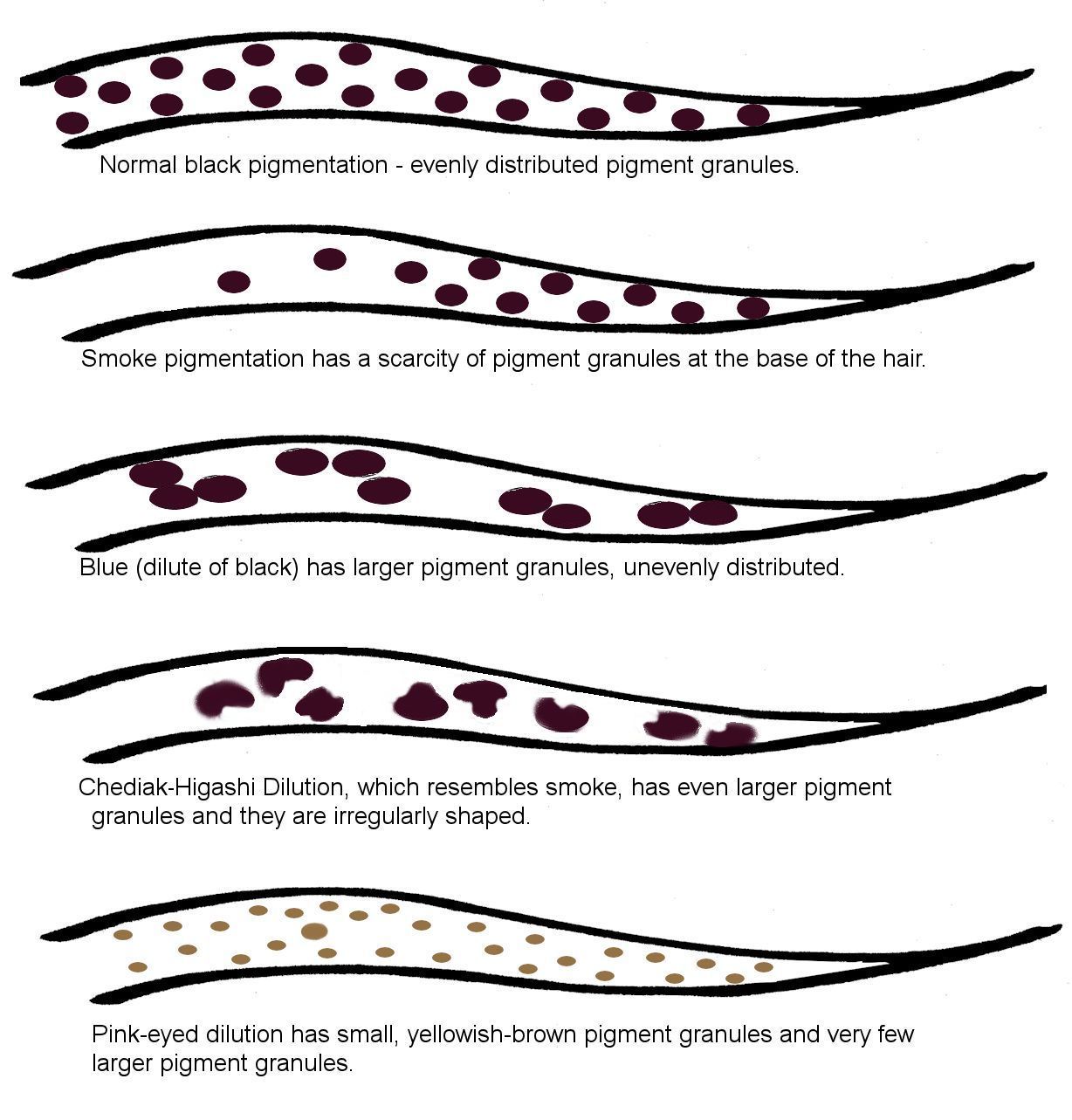
Simplified Diagram Of Pigment Granules In Cat Hair - based on the microscopy examination photos
Prieur & Collier (1981) compared the melanin granules in hair of black, smoke, blue, Chediak-Higashi-smoke, and pink-eyed dilution cats. A portion of the preserved skin of the pink-eyed dilute cat was used in this study.
- Prieur DJ, Collier LL. Morphologic basis of inherited coat-color dilutions of cats. J Hered. 1981 May-Jun;72(3):178-82.
BLUE DILUTION
The normal dilution seen in cats is "blue dilution" that changes black to grey (blue), chocolate to lilac, and cinnamon to fawn. Blue dilution affects the skin and coat colour by altering the pigmentation granules, but leaves the eyes pigmented.
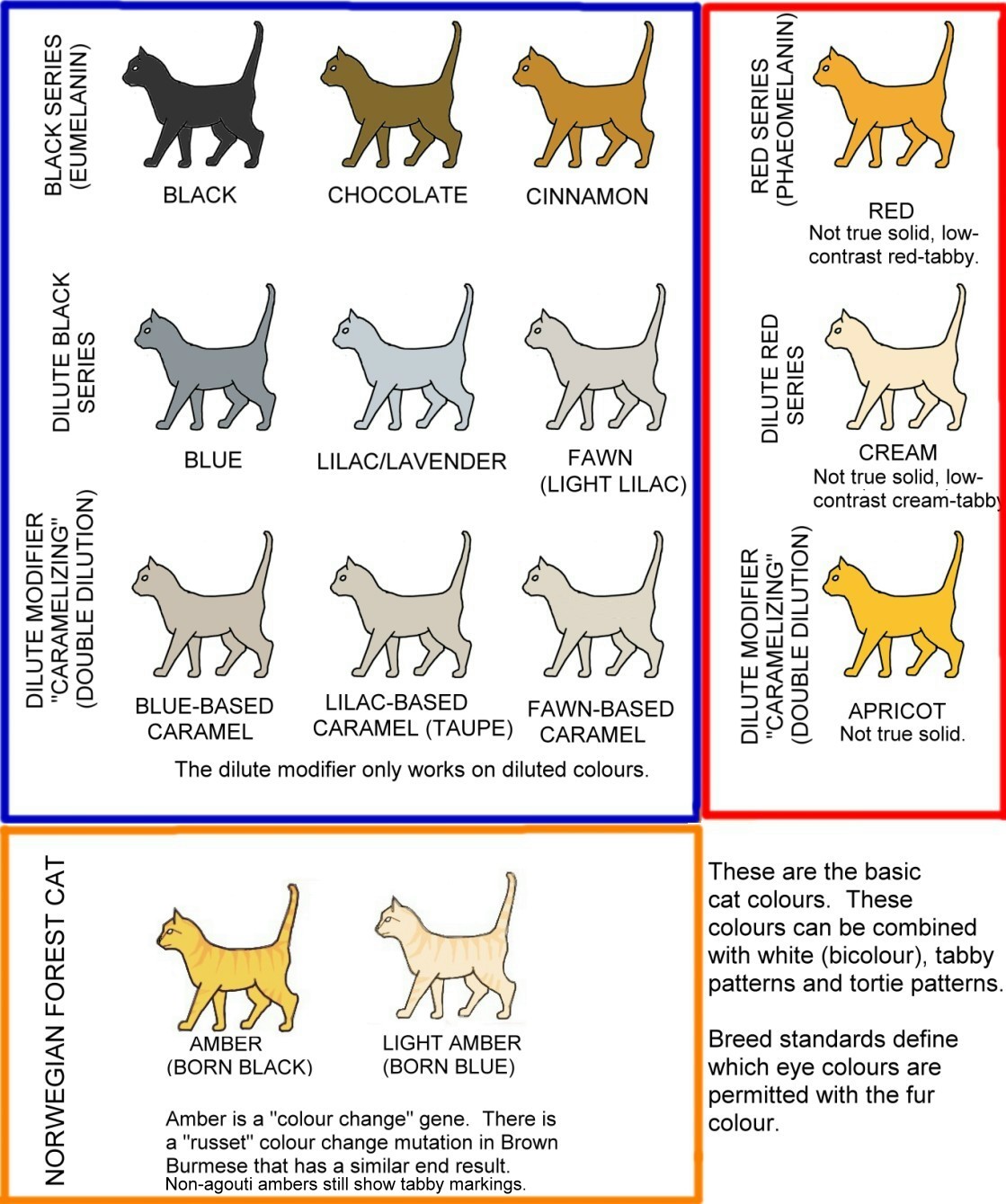
How Blue Dilution Affects Different Colours
Prieur DJ, Collier LL. Maltese dilution of domestic cats. A generalized cutaneous albinism lacking ocular involvement. J Hered. 1984 Jan-Feb;75(1):41-4. "The Maltese dilution is an autosomal recessive trait of cats that dilutes black cats to blue, and orange cats to cream. The pigmented cutaneous and ocular tissues of Maltese dilution and control cats were examined and compared by light microscopy. Most of the melanin granules in all of the pigmented cutaneous tissues of the Maltese dilution cats were aggregated together into large clumps. However, none of the intraocular tissues containing melanin producing cells of either neural crest or optic cup embryologic origin contained clumped melanin granules. It is concluded that the Maltese dilution trait is a unique generalized albinism without ocular involvement."
PINK EYED DILUTION
Pink-eyed dilution is found in a number of mammals but there is only one good account of it in cats. It changed black to a fawn/bluish-tan colour and the eyes had a red pupil and gold flecked red/pink irides (the coloured section around the pupil). There may have been occasions where pink-eyed dilution has been confused with pink-eyed albino which is reported sporadically in cats.
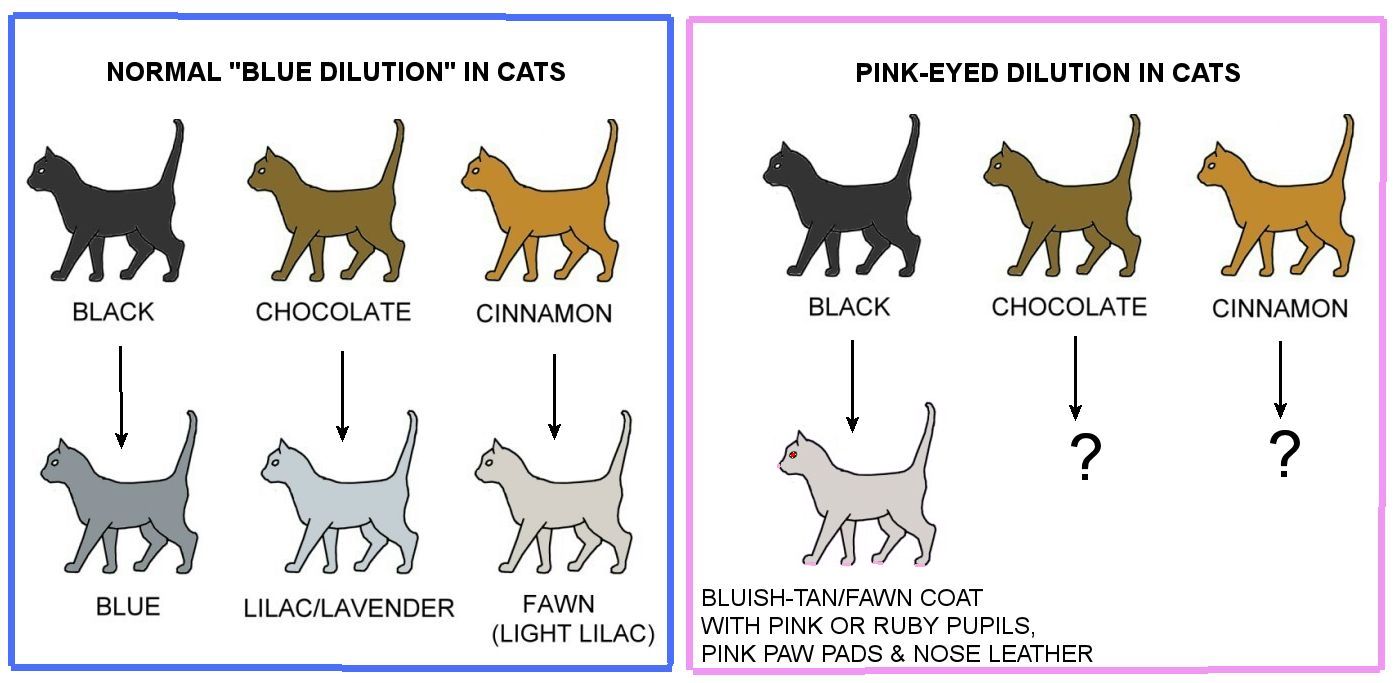
Analysis of hairs from the preserved skin of the female pink-eyed dilute showed very small yellowish-brown melanin granules and very few larger granules. The base of the hair was paler than the tip and some hairs had lighter banding (agouti banding) that was only visible under magnification. The tip of the hair was coloured.
For those with a scientific background, I’ve included details from the two known studies of the single confirmed cat with this mutation.
Pink-Eyed Cats /Albino Series
To untangle the different pink-eyed mutations, here is a short description of the albino series in cats showing where pink-eyed albino fits in. It is the most recessive of the albino alleles (gene variants). A pink-eyed albino has an unpigmented white coat. A pink-eyed dilute has a coloured coat (right now we don’t know how pink-eyed dilution interacts with dominant white (white masking)).
Temperature-sensitive albinism in cats is caused by tyrosinase (TYR) mutations. For the molecular genetically minded, it is a cytosine deletion in the TYR gene. Cat fanciers refer to it as the "C" locus (a sort of genetic "address"). Albino cats have been reported in scientific literature (Todd 1951; Turner et al. 1981) but their eye-colour has not always been well described. Blue-eyed albinos have not been properly distinguished from pink-eyed albino cats (Bamber & Herdman 1931; Todd 1951; Leventhal 1982; Leventhal et al. 1985). This made it unclear as to whether there were more than "one non temperature-sensitive albinism alleles" in cats i.e. both blue-eyed and pink-eyed. Lyons believed the single report of a red-eyed albino cat to be erroneous (Imes et al. 2005), but since 2005 there have been more reports and photographs of pink-eyed albino cats (this mutation has entered the Bengal breed via the Asian Leopard Cat). Because of the cat's eye structure, pink-eyed albinos often appear lilac-eyed with a red pupil, however the coat is always white. Blue-eyed albinos have pale blue irides and must not be confused with "blue-eyed white" cats that have the white masking gene and vivid blue eyes.
So a "pink-eyed albino" is a white cat with pink (unpigmented) eyes. This is different from "pink-eyed dilution" which has a light tan or dull cream coat and yellow eyes with red pupils (i.e. they reflect red not green). A test-mating of a female pink-eyed dilute to a colourpointed cat demonstrated that the pink-eyed dilution is recessive, but it's not on the "C" locus and therefore isn't related to the known albino series. This makes it interesting to cat fanciers as a potential new variety, providing it doesn't have any damaging side-effects. This was documented by Neil B Todd in 1961:
A Pink-Eyed Dilution in the Cat - Neil B Todd (1961)
September 1961, 52 (5) - Journal of Heredity
It was the author's original intention to report in detail on the genetic basis, if any, for the cat to be described below. However, her untimely death due to an intestinal obstruction ended the work almost before it was started.
During the summer of 1958 three kittens from a litter were turned over to the SPCA in Springfield, Massachusetts. Their estimated date of birth was April 1958. Two of these animals were apparently quite ordinary, although not detailed description of them was available. The mother was presumably normal; the father was unknown. The third kitten, a female, had pink eyes (although a small amount of yellow pigment was present in the iris) and a light tan coat. She was a blotched tabby (dominant) with moderate white spotting (dominant) and had a slight kink at the tip of her tail. Her hair was short and dense with a fine texture. In all other respects she conformed to the wild type. It is suspected that she had some visual impairment from the rather clumsy way she would run into things and from her hesitancy to jump from a height which would not disturb most cats.
The animal apparently never came into heat spontaneously during the first three years of her life, but this may have been due to her caged existence rather than to any inherited or congenital defect. She was treated with hormones in January, 1961, and subsequently mated to a chocolate point Siamese. This cross was made with the purpose of discovering if any relationship existed between her phenotype and the albino series of alleles. A chocolate point Siamese is homozygous recessive for a pigment-determining allele at the albino locus (cbcb), for brown (bb) and for non-tabby (aa). [Note "+" meant "wild type" in the genetic nottion of tht time.]
The cross produced a litter of three kittens, born 10 days prematurely with the result that none survived. However, all were fully pigmented tabbies and therefore of the genotype +acb+bb+aa. From the data it can be concluded that the phenotype of the mother was due (if indeed genetically determined) to the homozygous recessive condition at some locus other than that of the albino series of the black-brown alternatives.
[Modern notation for the offspring: Aa Bb Ccs Dd oo T- (I’ve used “T” on its own because the report doesn’t say if the tabby is classic (Tc) or mackerel ( TM )]
Neil B. Todd
The Biological Laboratories, Harvard University
Pink-Eyed Dilution Described by Dr Friedrich Schwangart (1932)
The following comes from my translation of “Zur Rassebildung und Rassezüchtung der Hauskatze” (On Racial Constitution and Breeding Of The Housecat) by Dr Friedrich Schwangart (Dresden), 1932. This book has not been translated into English until 2018, so this description of a pink-eyed dilute (30 year's before Todd's specimen) has previously been overlooked. In addition to normal dilution, Schwangart’s interpretation of cat colours included leucism (white fur on pigmented skin), albinism (white fur on unpigmented skin) and flavism (dilution of any colour to cream). It is only with hindsight that we can identify this as pink-eyed dilution.
In Chapter V, “Colouring (of Hair, Skin, Eyes Etc.)” Schwangart writes: “As already mentioned, the characteristics of full-scale albinos include not only a completely pigment-free (white, pink) skin, but also eyes with a red-looking iris and an equally bright pupil. This scenario is exceptionally rare in the domestic cat. [. . .] I know of pigment-poor tints: a blue iris with a normal dark pupil where the pupil shines red, a case of a pale lemon-yellow iris with an intensely red shining pupil [. . .]"
A few paragraphs later, Schwangart further describes the cat with the lemon-yellow iris and red pupil and a dull cream body colour: “The albino relationship is revealed in the following case which we considered when enumerating pigmented eye types. The animal, a foundling, was very pale, dull cream colour, against which faded tiger stripes stood out on the torso. The iris is a pale lemon colour, the pupil has an intense red shimmer. Against my interpretation of this case as a Flavistic-Albinistic mutant with the peculiarity of still consistently recognizable striping, one could consider the possibility of a Tabby-Siamese hybrid such as TJEBBES (1924) has bred from a crossing of a grey tiger-tabby and a Siamese. However, our specimen also shows special signs of degeneration: her eyes are hypersensitive to light, and so far she has been in heat only at abnormally long intervals, and in those cases so inadequately that the hoped-for breeding attempts (mating with Siamese, red tabby, and others) could not be carried out. But it is mentally normal and is especially sociable and lively, but not irritable.”
Pink-Eyed Dilution in the Donskoy Breed (2015)
The two cats described in 1932 and 1961 seemed to be the end of it until 2015 when Kathryn Eden posted photos of Milkdud, a Donskoy (Don Sphynx kitten) whose colour defied analysis. Born to black parents, Milkdud’s genetic test results were:
Milkdud's skin was closer to a fawn colour and his eyes had yellow irides with red pupils. There is no genetic test for pink-eyed dilution. Photos exist of the original pink-eyed dilutes hairs under high magnification, so that is one route to investigate (the Don Sphynx has slight furring on the tail). The other is to breed furred cats with the same colour and eye colout and to analyse their fur. While the genetic basis isn't yet known, visually Milkdud appears to be a pink-eyed dilute and hence a new opportunity for the cat fancy.
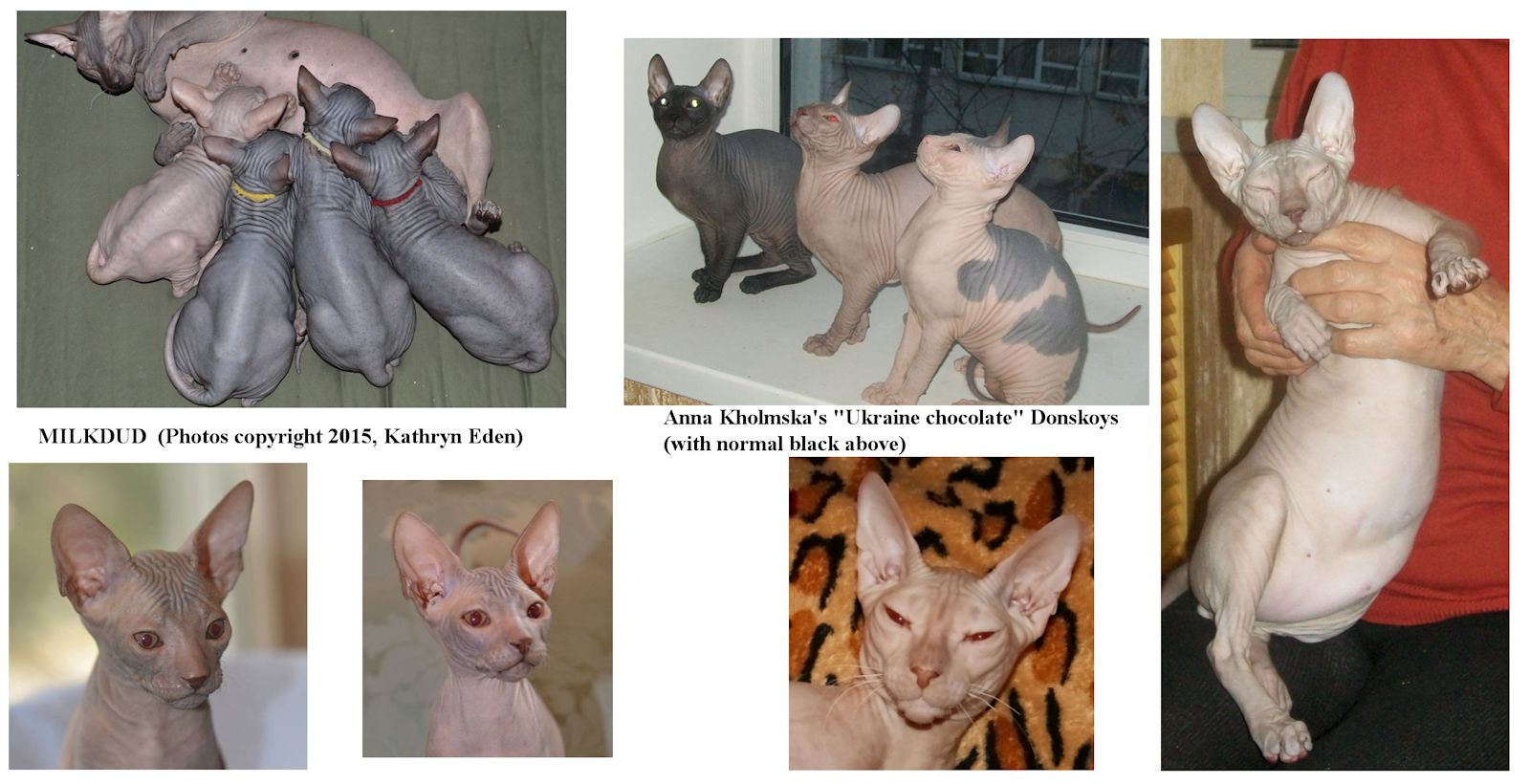
Anna Kholmska, in Ukraine, has bred 4 generations of these cats (over 7 years) to establish a breeding line. All have been healthy. The unidentified colour is known in discussion (during 2015) as "Ukraine chocolate." From the visual appearance, it closely resembles the description of pink-eyed dilution. What is exciting, is the possibility of a lost phenotype reappearing in cats. The colour also needs to be bred into furred cats for study. Anna notes that the chocolate colour (b at the TYRP1 (B) locus) is not accepted in the Donskoy, although it can be very attractive. For more than seven years, Donskoy Discovery has bred show-quality cats, including some that resembled chocolate colour. Unlike Chocolate Orientals, the Donskoys had an unusual eye colour that appeared pink in some lighting conditions. This was initially attributed to a combination of the chocolate gene with the dominant hairless gene, but the work of Kathryn Eden and Anna Kholmska and genetic testing has shown that the chocolate allele is absent. The cats need to be tested to confirm the presence of the dominant B allele (black). The coat and eye colour could be caused by a novel dilution of black (if B is present) or by some other mutation (if B is absent). All of the cats share a common ancestor. Their genotype (genetic makeup) shows they should be solid black but their phenotype (visual appearance) is chocolate. This indicates a diluted-colour but the cats do not have the dilution gene (d/d) at the D locus. In any case, “d” causes blue dilution i.e. black to grey. “d” is one of the three genes involved in melanosome transfer and translocation. The unexplained “Ukraine chocolate” seems due to a gene for which there is no test (at least in the cat).
Early on, the possible candidates genes were the other two melanosome transfer and translocation genes Myosin Va (MYO5A) and RAB27A, or genes involved in the synthesis of eumelanin other than TYRP1, for example, TYRP2. The other known dilutions in the cat are the extinct Barrington Brown cats (none of which were bred outside of a laboratory colony) and the single example of a pink-eyed dilution cat reported by Neil Todd.
By April, 2016, the genetic basis for the “pink-eyed”/”Ukraine chocolate” Donskoy kittens was being researched by Marie Abitbol, DVM, PhD, HDR, Lyon School of Veterinary Medicine, France. The parents of the pink-eyed cats are both black cats. The first results were released by Dr Marie Abitbol in February 2016. She received hairs from 5 Donskoy cats: 2 pink-eyed cats (unverified-colour), one black self-colour cat, a brown tabby cat and a red cat. She also compared a reference sample from a Chartreux cat, because this blue breed is homozygous for dilute (d/d for the D locus, MLPH gene and mutation).
The hairs from the black cat were uniformly and deeply pigmented with a dark-brown to black colour. The hairs from the brown tabby cat were deeply pigmented with a dark-brown colour. In some hairs we noticed a light-gold band as expected for agouti hairs from a tabby cat. The hairs from the first pink-eyed cat were uniformly pigmented with a light-brown colour. Hairs from the second pink-eyed cat included uniformly pigmented hairs and hairs with a light-gold band, both on a light-brown background. Dr Abitbol assumed that the second pink- eyed cat is genetically a tabby cat with agouti banded-hairs.
Melanin granules from the pink-eyed cats were lighter in colour than the brown granules observed in the brown tabby cat and the dark-brown granules observed in the black cat. It was not possible to measure the number or size of the granules, but it seemed that pink-eyed cats had less deeply pigmented granules than the black cat. The melanin granules appeared identical in shape between pink-eyed cats and the black cat. No enlarged granules, as found in the diluted (blue) cat, were found. The distribution of the melanin granules was regular along the hair of the self- coloured pink-eyed cat, which is the same distribution found in the self-coloured black cat. In contrast, in the diluted (blue) cat, the melanin granules are clustered and unevenly distributed along the hairs. This indicates that the colour phenotype observed in the two pink-eyed Donskoy cats is a modification of the dark pigment (eumelanin).
Pink-eyed Donskoys had yellow irises. In common with albinism, the fundus (interior surface at the back of the eye) lacked pigmentation and lacked a tapetum. This is consistent with Oculo-cutaneous albinism with residual skin and eye pigmentation, and is distinct from colourpoint cats (including mink, sepia, mocha) which have temperature-sensitive colour restriction.
Breeders of “pink-eyed” Donskoy cats described it as a recessive mutation. Genealogical (pedigree) data confirms it to be an autosomal recessive (not gender-linked). A “pink-eyed” cat carries two copies of the mutation involved in the “pink-eye” phenotype. A carrier cat has only one copy of the mutation and is “normal-eyed”. A non-carrier cat has no copy of the mutation and is normal-eyed. This means 2 pink-eyed cats bred together will produce only “pink-eyed” offspring. A pink-eyed cat mated to a carrier will produce both “pink-eyed” and carrier offspring. Two carriers of the mutation, can produce a mix of normal-eyed, pink-eyed and carrier offspring.
This indicates that the pink-eye phenotype is caused by a single gene. DNA from cheek swabs from pink-eyed cats are being analysed by Dr Abitbol. Because the Donskoy “pink-eye” phenotype resembles the pink-eye mouse and non-syndromic oculocutaneous albinism (OCA) in humans, these sequences were investigated in the cats’ DNA samples. Dr Abitbol analysed the DNA from one pink-eyed cat, for 8 genes involved in OCA (which includes the gene that produces the pink-eye mutation in the mouse). There were several variations in the DNA sequence from the pink-eye cat when compared to the reference sequence of a fully pigmented cat. In the pink-eyed cat, one of these variations was present in two copies, which concurs with a recessive mutation. However, two other pink-eyed cats had only one copy of this variation which rules out this mutation as the cause of the pink-eye phenotype. While the phenotype of the pink-eye cats resembled the pink-eyed mouse and OCA human, a different gene appeared to be responsible in the pink-eyed cats. This necessitated a “genome wide” approach to comparing DNA from multiple pink-eyed Donskoy cats, and from normal-eyed Donskoy cats, including relatives of the pink-eyed cats and unrelated cats.
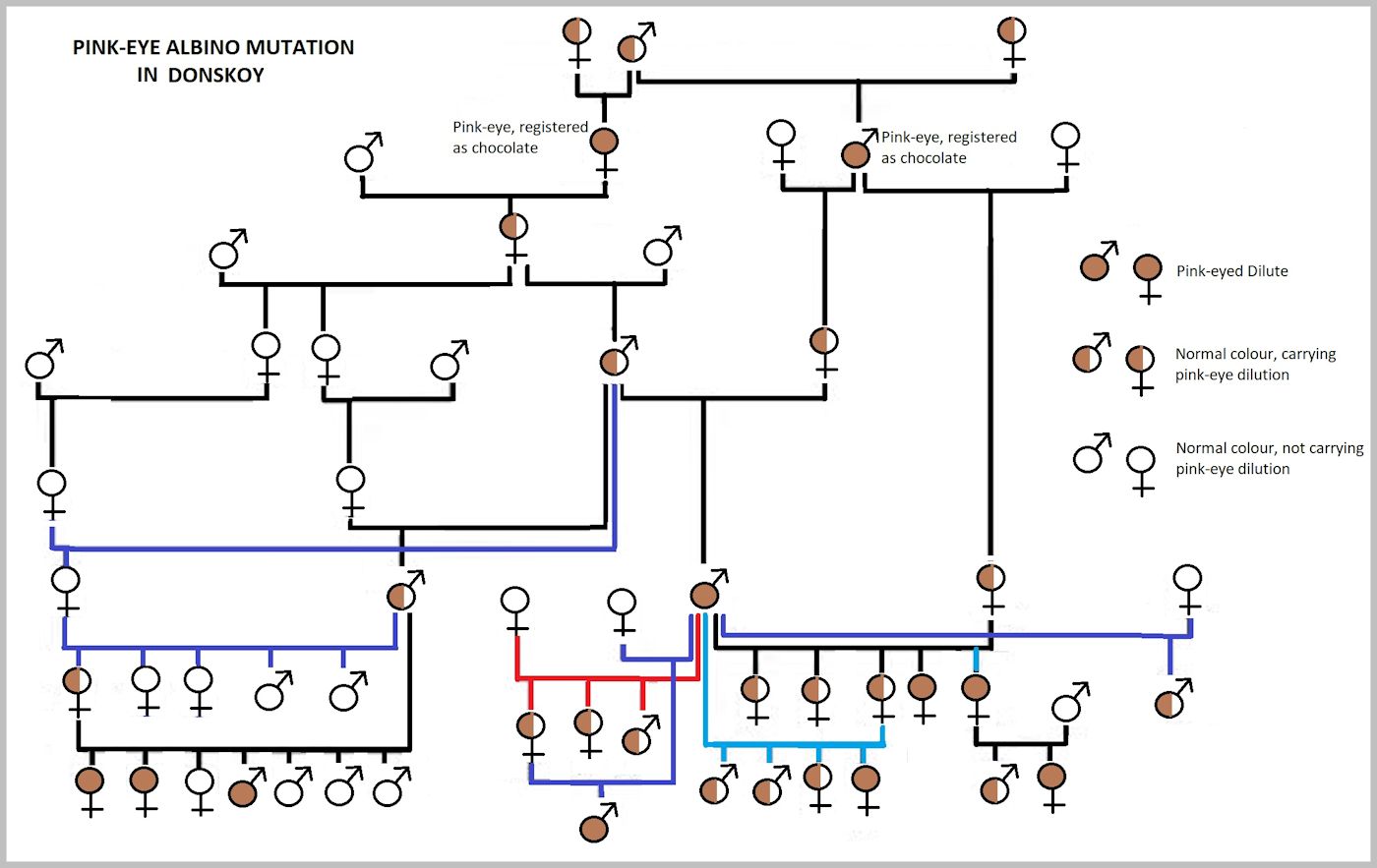
In June 2020, a report was published, identifying the pink-eye gene: “Donskoy cats as a new model of oculocutaneous albinism with the identification of a splice-site variant in Hermansky–Pudlak Syndrome 5 gene” by Marina Meriot, Christophe Hitte, Maud Rimbault, Caroline Dufaure de Citres, Vincent Gache, Marie Abitbol (Pigment Cell Melanoma Res. 2020;00:1–12.)
Using cheek swabs and blood samples, the researchers identified HPS5 (HPS5 Biogenesis Of Lysosomal Organelles Complex 2 Subunit 2) as a likely candidate gene, because HPS5 variants have been identified in humans and animals with Hermansky–Pudlak syndrome 5 or oculocutaneous albinism. A mutation in this gene was identified in pink-eye Donskoy cats, but was not present in 170 cats from 19 breeds and non-breed domestic cats that were also tested. The pink-eye Donskoy cat is a new HPS5 variant. HPS5, which is also found in mice, is a mild form of Hermansky–Pudlak Syndrome, without the complications present in other forms of HPS i.e. normal vision, no tendency to bleed.
As to where in the ancestry the pink-eye HPS5 mutation originated, it was probably early on in breed development. Before breed recognition, Donskoys were outcrossed to Domestic Shorthair cats to widen the gene pool, and to Siamese and Oriental Shorthairs to create the Peterbald. Outcrossing stopped around 2005. None of the outcross breeds have shown the pink-eye mutation. Because the mutation isn’t seen in other purebreds, the pink-eye gene may have come from a domestic shorthair outcross (in Russia/Ukraine), or from the original Donskoy foundation female, or as a spontaneous mutation during breed development.
The mutation appears cosmetic in cats and has show-bench potential. The downside of having this mutation is that pink-eye cats could become laboratory subjects for investigating HPS in humans. This would involve owners/breeders releasing pink-eye breeding stock to laboratories, something I personally hope will not happen.
REFERENCES & OTHER INTERESTING READING